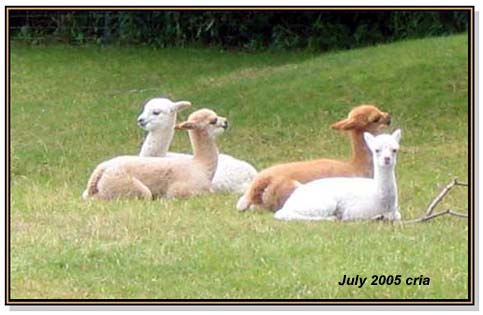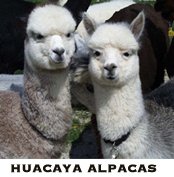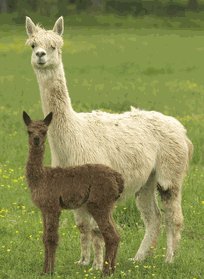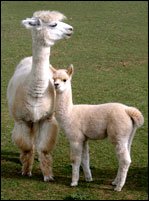About Alpacas
About Alpacas

About Alpacs
Alpacas were a cherished treasure of the ancient Incan civilization and played a central role in the Incan culture that was located on the high Andean Plateau and mountains of South America. Alpacas were first imported to the United States in 1984. Alpacas are now being successfully raised and enjoyed throughout North America and abroad. There are two types of alpacas - the Huacaya and the Suri. The lifespan of the alpaca is about 20 years and gestation is 11.5 months. Alpacas eat grasses and chew a cud. Adult alpacas are about 36" tall at the withers and generally weigh between 100 and 200 pounds. They are gentle and easy to handle. Alpacas don't have incisors, horns, hooves or claws. Clean-up is easy since alpacas deposit droppings in only a few places in the paddock. They require minimal fencing and can be pastured at 5 to 10 per acre.


Alpacas produce one of the world's finest and most luxurious natural fibers. It is clipped from the animal without causing it injury. Soft as cashmere and warmer, lighter and stronger than wool, it comes in more colors than any other fiber producing animal (approximately 22 basic colors with many variations and blends).This cashmere-like fleece, once reserved for Incan royalty, is now enjoyed by spinners and weavers around the world.
Alpaca owners enjoy a strong and active national organization. The Alpaca Owners and Breeders Association (AOBA) with a growing number of Regional Affiliates and AOBA sanctioned national committees addressing every aspect of the industry.
The Alpaca Fiber Cooperative of North America (AFCNA) accepts fleece from its members, and turns the precious textile into quality alpaca garments and products. Members benefit from a ready outlet for their fiber, while the cooperative works to increase awareness of and demand for this every day luxury.
The Alpaca Registry has been established to help ensure accurate records and has a state-of the-art system to document bloodlines. Alpacas must be blood typed in order to be registered. Virtually every alpaca in the U.S. is registered.
History of Alpacas
Alpacas have coexisted with humankind for thousands of years. The Incan civilization of the Andes Mountains in Peru elevated the alpaca to a central place in their society. The imperial Incas clothed themselves in garments made from alpaca and many of their religious ceremonies involved the animal. Museums throughout the Americas display textiles made from alpaca fiber.
The Spanish conquistadors failed to see the value of alpaca fiber, preferring the merino sheep of their native Spain. For a time, alpaca fiber was a well-kept secret. In the middle 1800's, Sir Titus Salt of London, England rediscovered alpaca. The newly industrialized English textile industry was at its zenith when Sir Titus began studying the unique properties of alpaca fleece. He discovered, for instance, that alpaca fiber was stronger than sheep's wool and that its strength did not diminish with fineness of staple. The alpaca textiles he fashioned from the raw fleece were soft, lustrous, and they soon began making their mark across Europe. Today, the center of the alpaca textile industry is in Arequipa, Peru; yarn and other products made from alpaca are sold primarily in Japan and Europe.
Outside of their native South America, the number of alpacas found in other countries is extremely limited. In fact, 99 percent of the world's approximately three million alpacas are found in Peru, Bolivia, and Chile.
Life Style
The joy, ease of care and potential profitability of raising alpacas has attracted people from many walks of life to become breeders. For some, alpacas are a primary source of income, for others a part-time business venture, but a source of pleasure for both. Young couples with children can enjoy the benefits of owning and caring for alpacas as a rewarding family experience. People who have raised their kids and are seeking a business and lifestyle to enjoy as they approach retirement are often owners. Ultimately, whether making the switch from a fast-paced, corporate way of life, or adding alpacas to an already established rural setting, breeding these unique, gentle animals can provide both income and pleasure, all included in a peaceful, stress-free lifestyle.
This lifestyle is made possible since alpacas can be raised on relatively small acreage and they are clean, safe, quiet, intelligent and disease resistant. Alpacas have soft padded feet, are gentle on the land and can be easily transported.
There are also plenty of family-oriented alpaca events around the country, including local and state fairs, alpaca farm open houses and auctions, and larger shows hosted by alpaca organizations, the largest and most impressive being the annual Alpaca conference and show presented by AOBA. Some breeders also choose to get involved in selling products made from alpaca fiber as a hobby or an additional home-based business venture. The spinning and weaving of fiber is a skill that can lead to profits.
Alpacas have brought impressive financial returns to families all across America, but it's the fun and hands-on nature of this lifestyle that has really captivated people searching for a simpler and more rewarding way of life. Even if you don't have the land and are committed to a full-time career, you can still begin your alpaca adventure by purchasing and boarding at a nearby alpaca farm or ranch. A retired doctor who is now a full-time alpaca breeder had this to say, "I would rather raise alpacas than anything I've ever done. Breeding alpacas is a labor of love and can be very profitable."
The Earth-Friendly Alpaca
Alpacas have been domesticated for more than 5,000 years. They are one of Mother Nature's favorite farm animals. They are sensitive to their environment in every respect. The following physical attributes allow alpacas to maintain their harmony with our Mother Earth.
- The alpaca's feet are padded and they leave even the most delicate terrain undamaged as it browses on native grasses.
- The alpaca is a modified ruminant with a three-compartment stomach. It converts grass and hay to energy very efficiently, eating less than other farm animals.
- Its camelid ancestry allows the alpaca to thrive without consuming very much water, although an abundant, fresh water supply is necessary.
- The alpaca does not usually eat or destroy trees, preferring tender grasses, which it does not pull up by the roots.
- South American Indians use alpaca dung for fuel and gardeners find the alpaca's rich fertilizer perfect for growing fruits and vegetables.
- A herd of alpacas consolidates its feces in one or two spots in the pasture, thereby controlling the spread of parasites, and making it easy to collect and compost for fertilizer.
- An alpaca produces enough fleece each year to create several soft, warm sweaters for its owners comfort. This is the alpaca's way of contributing to community energy conservation efforts.
Investment Potential
Investment facts
Alpacas have been called "the world's finest livestock investment." It is difficult to compare alpacas with other investments as pure investments. How much is peace of mind worth? Unlike the stock market, alpacas are depreciable over five years, giving the investor an immediate investment return in tax savings while the herd is growing.
Breeding stock held for more than one year is subject to capital gains, and alpacas qualify for Section 179 of the I.R.C. which allows an alpaca farmer to depreciate the first $100,000 of the investment. Consult your tax advisor on how it might benefit you. As you raise your alpacas, all expenses (i.e., food, veterinarian, supplies, computers, travel, tractors, showing, advertising, etc.), are deductible. In many states, those involved in farming will have a significant reduction in their real estate taxes. Unlike many investments, alpacas are 100% insurable.
Alpacas are not inexpensive, ranging from $10,000 to $40,000 for breeding females and $5,000 to $35,000 for high quality males. High quality proven males with exceptional offspring have sold in excess of $200,000. In many cases, financing your alpaca purchase can be done right on the farm as many alpaca breeders offer financing.
The alpaca herd grows at a limited rate, which helps to keep the supply and demand in check because:
Gestation periods are only eleven months to a year with single births.
The Alpaca Registry, Inc. (ARI) offers fully blood-typed protection and has been closed since 1998 to any newly imported animals.
The U.S. government does not currently have a high security portal into the U.S. for animals imported from countries that have hoof and mouth disease, which at this time includes Peru and Bolivia. The only high security quarantine station that was in operation in Key West, Florida was closed permanently by the Clinton administration.
Mass production techniques, such as embryo transfer and artificial insemination, are difficult, if not impossible, due to the physical characteristics of the alpaca. More importantly, the Registry will not recognize any animals that are not produced naturally.
The Alpaca Registry, Inc.
The Alpaca Registry, Inc. (ARI) offers fully blood-typed protection to all alpaca owners. The registry has been closed since 1998 to any newly imported animals. It is very important for investors of alpacas to purchase only ARI registered alpacas. You will not be able to register alpacas unless both of their parents are currently registered with ARI.
All you need is love
Adding to the overall investment picture is the fact that alpacas are inexpensive to raise, require small acreage, and are very hardy animals. Friendly and trainable yet hardy and tough, the alpaca is truly an investment you can hug. Have you ever hugged your stocks?
Apaca Facts
Since ancient times, the South American Andes Mountains have been the ancestral home to the prized alpaca. Their fleece was cherished by members of the Incan civilization (referred to as "The Fiber of the Gods"), and their graceful herds of alpaca roamed the lush foothills and mountainous pastures. In the 17th century, Spanish conquistadors killed a large part of both the Incan and alpaca populations, forcing the retreating survivors to seek refuge in the high mountain plains known as the Altiplano. The high altitude and harsh landscape ensured only the hardiest of these creatures survived, and these ancestors of today's best bloodlines have provided a gene pool producing hardy, agile animals with dense, high quality fiber. In 1984, a small group of importers brought the first of a carefully selected herd of highest quality alpacas into the United States and Canada, and they immediately became a beloved part of the North American landscape.
Peru, Bolivia, and Chile are still home to the largest percentage of alpacas in the world, and alpaca breeders in the United States have learned much from their southern neighbors. Alpacas are a member of the camelid family, which also includes dromedary and Bactrian camels, llamas, vicunas, and guanacos. They are a modified ruminant and chew their cud similar to a cow, although they have three stomachs rather than the true ruminant, which has four. Alpacas selectively graze, eating pasture grasses and hay, a fact that makes feeding alpacas relatively inexpensive. A daily mineral supplement rounds out their diet.
There are two different alpacas types, the suri and the huacaya. The suri has fiber that grows quite long and forms silky, pencil-like locks. The huacaya has a shorter, dense, crimpy fleece, giving it a very woolly appearance.
Alpacas have soft padded feet, making them gentle on their pastures, and they have no top teeth in the front. The average height of an alpaca is 36" at the withers, and they weigh from 100 to 175 pounds. Alpacas are small and gentle enough to travel short distances in the family minivan and are easily handled by most people.
Alpacas have a life span of 15 to 20 years, so you can enjoy your alpaca for a long time. Not only do they have a long reproductive life, they will provide fleece for a lifetime, making your investment long-lived.
An alpaca's gestation period is 11 to 12 months, and they have single births (twins are extremely rare). A baby alpaca, called a cria, usually weighs between 15 and 20 pounds.


Alpaca fiber comes in 22 colors that are recognized by the textile industry, and there are many blends in addition to that. Alpacas are shorn for their wonderful fleece each year, which will produce 5 to 10 pounds of soft, warm fiber that is turned into the most luxurious garments in the world. When it comes to raising alpacas, there is something for everyone.
Frequently Asked Questions About Alpacas
What is an alpaca?
An alpaca is a member of the camelid family. Most closely related to Llamas, and descendants of camels. Alpacas are small, gentle animals raised primarily for their soft, luxurious fiber. Their valuable fleece is harvested annually by shearing them in a way similar to the way sheep are shorn each spring.
What is the difference between llamas and alpacas?
Llamas were raised for centuries in South America as beasts of burden. Alpacas have been breed for thousands of years for their fine fiber.
Where are alpacas from?
Alpacas are native to South American Andes Mountains and can be found in Chile, Bolivia and Peru.
Are there alpacas in the US?
Alpacas are thriving in just about every state in the US and are in several providences within Canada.
How many alpacas are in the US?
There are over 30,000 registered alpacas in North America.
Are there alpacas near me?
Sure! To find an alpaca farm near where you live call the Alpaca Owners and Breeders Association for an information booklet on alpacas and alpaca farms near you.
Call 1-800-213-9522
On the web: Alpaca Owners and Breeders Association
How long have they been raised in the US?
Alpacas were first imported into the United States in 1984.
What are alpacas used for?
Alpacas are fiber-producing animals. In the US, they are bred for their investment potential as breeding stock as well as for their valuable fiber which is sheared off the animals each spring.
Are there wild alpacas?
No. Alpacas have been domesticated for over five thousand years. Without the assistance of man, alpacas would not survive in the wilds. They lack defenses that would protect them from predators.
How long have alpacas been raised?
Records show that Alpacas have been raised for over five thousand years, however there is speculation that they have been utilized for over nine thousand years.
How long has alpaca been used as clothing?
Alpaca was the fiber reserved for Inca royalty dating back thousands of years. In the mid 1800's Sir Titus Salt (England) discovered the alpaca fiber and fashioned the first modern alpaca garments.
Where can I learn more about alpacas?
There are many Internet sites featuring alpacas or you can contact
Alpaca Owners and Breeders Association at 1-800-213-9522
On the web: http://www.alpacainfo.com/
What is the difference between suri and huacaya alpacas?
Huacaya alpacas have soft and crimpy fiber. Suri alpacas have long pencil like locks that are silky and lustrous. Underneath their "hair styles", they are basically the same.
Do people show the animals?
Yes! Shows are in all areas of the country and make great family events.
Frequently Asked Questions About Alpaca Fiber

Are the alpacas killed to get the fiber?
No. Alpacas are sheared, much like sheep, every year. Alpacas are much cooler and happier in warm weather once the fiber is removed. The fiber regrows by the time cool weather comes again.
How often are alpacas sheared?
Most alpaca producers in the United States shear once each year.
How many colors does alpaca fiber come in?
Alpacas come naturally in 22 color variations; the spectrum includes white, fawn, brown, gray and black, with all the natural shades in between. Alpaca dyes beautifully and is available in 18 colors through the cooperative. The color spectrum is as vast as your imagination if you choose to dye your own yarn.
What does fiber feel like?
Alpaca has softness like no other natural fiber. Huacaya alpaca is crimpy and soft. Suri alpaca is silky and lustrous. Most people find it to be without the itch associated with wool. It is also very lightweight, yet warmer than wool.
What is the difference between sheep wool and alpaca fiber?
Sheep's wool has a different physical make-up than that of alpaca fiber. The outside of each strand of wool has tiny, microscopic scales along the length of the strand. When garments made with wool are worn next to the skin, these scales catch the surface of the skin and cause some wool to feel prickly. Strands of alpaca fiber are smooth and therefore feel less prickly or itchy next to the skin. Alpaca too, is lanolin free (lanolin holds dust and microscopic allergens that create allergies to wool), which allows for the hypoallergenic nature of the fiber. Each individual strand of fiber is hollow. This gives alpaca a tremendous thermal capacity that allows for a breathable fiber with an insulating nature. Alpaca insulates from cool and warm temperatures.
What is the difference between suri and huacaya fiber?
Huacaya fiber is crimpy and soft. Suri fiber is silky and lustrous. Both types of fiber are luxurious and warm.
Does alpaca itch like wool?
Most people who are sensitive to woolen products find that they can wear alpaca without the same sensitivity.
Is alpaca warm?
Yes. Alpaca fiber has a hollow core that gives it great thermal properties. While being warm in cold weather, it can breathe and is comfortable for any season.
Will I be allergic to alpaca?
Most people who have wool based allergies will not be allergic to alpaca. Alpaca doesn't contain lanolin found in wool (lanolin holds dust and microscopic allergens that create allergies to wool), which allows for the hypoallergenic nature of the fiber.
Can alpaca be dyed?
Yes! Alpaca dyes beautifully. It can be dyed with natural or synthetic dyes.


